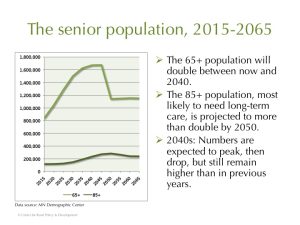
The age wave we’ve been expecting for the last 30 years is here now. Baby Boomers began turning 65 in 2011 and they’re only getting started. Between now and 2040, the 65+ population is expected to double, as will the 85+ population.
As they retire and move out of the workforce, though, communities both in Greater Minnesota and the Twin Cities metro will be facing the problem of where to find workers, particularly in the health care industry. While the state’s total population is expected to continue growing, the workforce age population is projected to decrease, then finally level off at a size lower than where it is today. As a share of the total population, people age 15-64 stand at about 65% of the state’s population today. In 30 years, they are projected to make up only about 55% of the population, according to the Minnesota State Demographic Center.
Between now and 2045 the worker shortage will be felt particularly in the field of long-term care. While long-term care facilities across the state are dealing with worker shortages even now, dynamics in rural areas are making the shortage problem worse. The Center has prepared a short collection of slides outlining the issues for Greater Minnesota when it comes to finding people to care for our seniors, some takeaways, and some suggestions on what can be done to help.
Our findings:
• The workforce shortage is the single biggest problem facing long-term care today.
• Recruitment and retention are significant problems for long-term care providers in rural areas.
• The workforce shortage affects rural seniors in unique ways, including fewer options when it comes to in-home or assisted living care and the possibility of being forced to move far from friends and family if the nursing home needs to limit intake.
